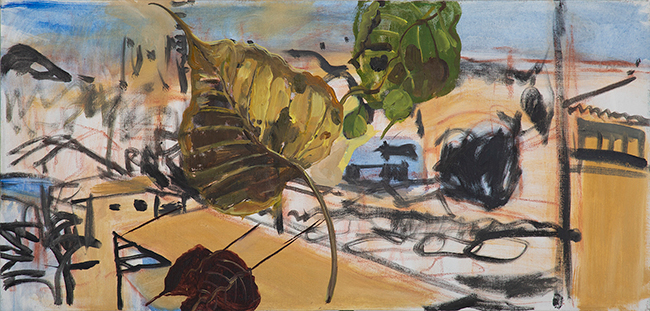מיכל גולדמן — פיקוס רליגיוזה
חמישי, 04.04.19 | שעה 20:00

אודות התערוכה
במשך שבעה שבועות נח גאוטמה בודהה בצלו של עץ התאנה הקדושה- עץ הבודהי- עץ החכמה, ביצע מדיטציה וזכה להארה. שמותיו הגרנדיוזיים של עץ הפיקוס רליגיוזה לא רומזים על עצם היותו שכיח למדי, נקלט בנקל, גדל בכל סוגי הקרקע, חזק, עמיד למחלות, לשרב ולקור, עץ ענק עם שורשים ציוריים ומשום כך זוכה לפאר את רחובות תל אביב. כאשר מיכל גולדמן מציבה אותו במרכז הפריים בסדרת עבודות חדשות, היא מדגימה הלכה למעשה את התופעה שדווקא הרגיל, היומיומי, המובן מאליו בשכונתה והנמצא מתחת לאף, הוא הגורם להשראה- כעלה יחיד וכעץ רב הוד.
זהו פרק המשך בנושא שאליו חוזרת גולדמן – פיסות זעירות, כביכול שוליות, מן הטבע, מובאות אל הסטודיו ומצטיירות באור צפוני במנותק ממקור גידולן. גולדמן מביימת את העלה, העלים והענף של הפיקוס כמו את ה”זר של אורה”, את ה”עשב הלימוני” ואת ה”גרניום” – סדרותיה הקודמות. אלא שהפעם, נוספת תפנית מפתיעה ומרגשת. כשגולדמן מציירת עלה ענק דמוי לב, עם נימים ואונות, מדויק ושקוף, המכסה ציור שנס לחו בעיניה, היא מגשימה באופן מובהק את תמצית הרעיון הבודהיסטי שבו כל התופעות הן בנות חלוף. הוויתור על ההקפדה, הרגישות, הצבעוניות והעצמה שהיו בדימוי הראשוני מותיר אותם מבצבצים תחת עלה חום בשלכת שנאסף מן הרחוב ויוצר דימוי חדש, רב כוח ומפתיע. מטמורפוזה של ציור.
הניגודיות מועצמת עם הצבתם בפריים של עלים בודדים, היוצרים קבוצה מרקדת בתוך מרחב הסטודיו האובייקטיבי והמאוזן.
בהמשך התהליך, יוצאת גולדמן מד’ אמותיו של הסטודיו אל הרחובות, ומנציחה במצלמת-טלפון את העצים בסביבתם הטבעית-אורבנית: צומת, פינה, מדרכה, ליד עמודי חשמל ומעקות. בסטודיו, היא בוחרת את הדימויים בהם הקומפוזיציה מעצימה את הניגוד בין העצים גדולי הממדים לשאון העיר, בין התכנון האורבני לבין הטבע המשתנה תדיר- מצמיח חוטרים ומשתלט על תכניות האדם.
בשיאו של התהליך, גולדמן מצלמת את העצים מנקודת מבטו של השורש- מעין דיוקנאות עצמיים של עצים. הקומפוזיציה הציורית שנוצרת אקספרסיבית, מדויקת ונועזת: העצים הנטועים עמוק באדמה נמצאים בתנועה מתמדת, מרקדים, מתערטלים ושמחים.
בעבודותיה אלה הנסמכות על אילנות גבוהים, אמרות ההארה של גאוטמה בודהה, התבוננות ומיומנות, מזקקת גולדמן תוכן, טכניקה ופילוסופיה ברגישות והעזה.
אוצרת
חנה קומן
נעילת התערוכה
11.05.19
Michal Goldman — Ficus Religiosa
Thursday 04.04.19 | at 20:00
For seven weeks Gautama Buddha rested in the shadow of the sacred fig – the Bodhi tree – the tree of wisdom, meditated and attained enlightenment. The grandiose names of the Ficus Religiosa do not hint that it is quite prevalent, easily acclimatized, growing in all soil types, strong, resistant to diseases, heat waves and frost, a gigantic tree with picturesque roots, and therefore selected to adorn the streets of Tel Aviv. When Michal Goldman positions it at the center of the frame in a new series of works, she demonstrates in practice the phenomenon that the ordinary, quotidian, taken for granted in her neighborhood, ubiquitous, is the source for inspiration – as single leaf and as majestic tree.
This is the sequel in the topic to which Goldman keeps returning – minute scenes, supposedly marginal, from nature, are brought into the studio, and are drawn under a northern light detached from their growth origin. Goldman directs the leaf, the leaves and the branch of the Ficus like “Ora’s Bouquet”, “Lemon Grass” and “Geranium” – her previous series. Only this time a surprising, exciting twist is added. When Goldman paints a gigantic heart-like leaf, complete with veins and lobes, precise and translucent, covering up a previous painting that has lost favor in her eyes, she realizes the essence of the Buddhist idea that all phenomena are fleeting. Renouncing the punctiliousness, sensitivity, colorfulness and potency that were present in the original image, leaving them showing under a brown autumnal leaf collected from the street, creating a new image, potent and surprising. The metamorphosis of a painting.
The contrast is intensified by the positioning in the frame of single leaves forming a dancing group in the objective, balanced space of her studio.
As the process progresses Goldman leaves the intimacy of the studio for the streets, documenting the trees with a phone camera in their natural urban habitat: crossroad, corner, sidewalk, near electric power poles and banisters. In the studio she selects the images where the composition intensifies the contrast between the generously sized trees and the city hubbub, between urban planning and ever-changing nature – shooting forth twigs and taking over man’s plans.
At the climax of the process Goldman photographs the trees from the root’s viewpoint – a sort of trees’ self portrait. The picturesque composition created is expressive, precise and bold: the trees, planted deep in the ground are in constant motion, dancing ecstatically.
In these works, derived from great precedents, Gautama Buddha’s illuminated sayings and her own powers of observation and dexterity, Goldman distills substance, technique and philosophy with great sensitivity and courage.
